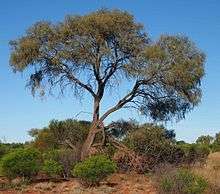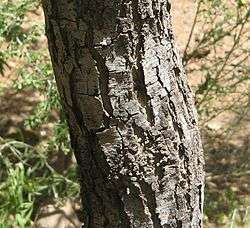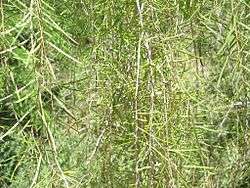Acacia estrophiolata
| Southern ironwood | |
|---|---|
 | |
| Scientific classification | |
| Kingdom: | Plantae |
| (unranked): | Angiosperms |
| (unranked): | Eudicots |
| (unranked): | Rosids |
| Order: | Fabales |
| Family: | Fabaceae |
| Genus: | Acacia |
| Species: | A. estrophiolata |
| Binomial name | |
| Acacia estrophiolata F.Muell. | |
Acacia estrophiolata, commonly known as ironwood or southern ironwood, is a tree native to Central Australia.
It is a graceful, pendulous shade tree, which grows from about 4-16 m tall[1] and has a trunk with a diameter of up to about 0.45 m.[2] Young plants are spiky leaved. It has pale yellow flowers after winter rains.
It is usually found in areas with about 220-350 mm/year of average rainfall.[2]
Uses
Food
Traditionally, Australian Aborigines would use the gum from the tree as a sweet bushtucker treat. Its name in the Arrernte language of Central Australia is Ngkwarle athenge arlperle. It is still sometimes eaten today.

The gum is snapped off the branches, either clear or red. It is then be ground and mixed with a little water, then left to set again to a chewable gum, and eaten with a small stick.
Forage
The tree makes good forage for livestock.[2] The seeds are edible and are 28.9% protein.[3]

Traditional medicine
Parts of the tree are used topically to treat skin problems such as burns, cuts, scabies, sores and it is also used for treating major wounds. It is used as a lotion to treat eye problems.[4]
Wood
The wood is very hard and it is good for making posts for fences.[2] It is used by indigenous Australians to make spears and arrows.[5]
References
- ↑ Acacia estrophiolata (WorldWideWattle)
- 1 2 3 4 FAO Archived July 9, 2008, at the Wayback Machine.
- ↑ Food Standards Australia New Zealand Archived September 14, 2007, at the Wayback Machine.
- ↑ TRADITIONAL ABORIGINAL MEDICINE PRACTICE IN THE NORTHERN TERRITORY Dr. fish Archived September 8, 2007, at the Wayback Machine.
- ↑ Sunshine Wattle (German)